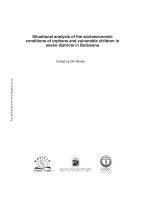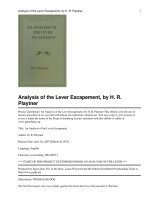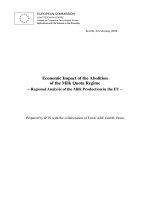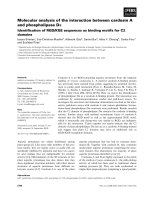Molecular analysis of the gene LAS17 mediating t DNA trafficking inside yeast cells
Bạn đang xem bản rút gọn của tài liệu. Xem và tải ngay bản đầy đủ của tài liệu tại đây (1.21 MB, 74 trang )
MOLECULAR ANALYSIS OF THE GENE LAS17 MEDIATING
T-DNA TRAFFICKING IN YEAST CELLS
HARIPRIYA BATHULA
DEPARTMENT OF BIOLOGICAL SCIENCES
NATIONAL UNIVERSITY OF SINGAPORE
2010
MOLECULAR ANALYSIS OF THE GENE LAS17 MEDIATING
T-DNA TRAFFICKING IN YEAST CELLS
HARIPRIYA BATHULA
(B.pharm, M.Tech)
A THESIS SUBMITTED
FOR
THE DEGREE OF MASTER OF SCIENCE
DEPARTMENT OF BIOLOGICAL SCIENCES
NATIONAL UNIVERSITY OF SINGAPORE
2010
ACKNOWLEDGEMENTS
I would like to thank my mentor Associate Professor Pan Shen Quan for his
invaluable guidance and patience, without which this study would not be have been
possible. Special thanks to my labmate Tu Haitao for the help extended during the initial
stages and also along the way. All my labmates have played a vital role in my journey as
a graduate student. So my special appreciation goes out to all the past and current
members of the Bacterial Genetics and Biotechnology laboratory for their support and
advice. I would also like to thank all the support personnel in the Department of
Biological Sciences for their help throughout the course of my research programme at the
National University of Singapore.
i
TABLE OF CONTENT
Pages
Acknowledgements
i
Table of contents
ii
Summary
v
List of Tables
vi
List of Figures
vii
List of Abbreviations
viii
CHAPTER 1
1.1 Aim of the project
1
1.2 Background of Agrobacterium tumefaciens
2
1.3 The Agrobacterium-mediated transformation (AMT) process
in plants.
4
1.4 Agrobacterium-mediated transformation of
Saccharomyces cerevisiae
8
ii
1.5 Background of Las17 gene
13
CHAPTER 2
Materials and Methods
2.1 General Materials and Methods
2.1.1 Yeast and Bacterial Strains
15
2.1.2 Culture media, antibiotics and Stock Solutions
15
2.1.3 Plasmids
16
2.1.4 Primers
16
2.2 DNA Manipulations
2.2.1Plasmid DNA preparation from E.coli.
22
2.2.2 Plasmid DNA preparation from A. tumefaciens
22
2.2.3 Polymerase chain reaction (PCR)
22
2.2.4 DNA gel electrophoresis and purification
23
2.3 Agrobacterium-mediated Transformation of S.cerevisiae
2.3.1 Cell culture
24
2.3.2 Induction of A .tumefaciens
24
2.3.3 Co-cultivation of A. tumefaciens and S. cerevisiae
25
2.3.4 Recovery and selection of transformants
25
2.4 Lithium Acetate Transformation of S.cerevisiae
27
2.5 PCR Detection of T-DNA inside Agrobacterium-transformed S.cerevisiae
iii
2.5.1 Co-cultivation and collection of Agrobacterium-transformed
S.cerevisiae
28
2.5.2 T-DNA extraction from Agrobacterium-transformed S.cerevisiae
29
2.5.3 PCR and gel electrophoresis analysis of T-DNA extracts
29
2.6 Fluorescent In- Situ Hybridization (FISH) Detection of T-DNA inside
Agrobacterium-transformed S.cerevisiae
2.6.1 Cell preparation and Fixation
31
2.6.2 Probes Preparation and Quantification
32
2.6.3 In Situ hybridization
33
2.6.4 Antibody detection
33
2.7 Cell Imaging
25
2.7.1 Fluorescent microscopy
34
2.7.2 Confocal microscopy
34
CHAPTER 3
Results and Discussion
3.1 The role of Las17 gene in Agrobacterium-yeast gene transfer
36
3.2 The effect of Las17 knock-out mutation on Agrobacterium-mediated
transformation.
3.3 The effect of ∆las17 on VirD2 nuclear targeting
37
43
3.4 The effect of Las17 knock-out mutation on T-DNA accumulation
inside yeast cells.
45
iv
3.4.1 The time course analysis of T-DNA accumulation inside the wild type
and Δlas17 yeast cells.
46
3.5 Detection of individual T-DNA molecules inside the yeast cells.
50
3.5.1 Percentage of yeast cells with T-DNA molecule at different
co-cultivation time points.
51
3.5.2 Average copies of T-DNA per yeast cells
53
Chapter 4
General Conclusion and Future Work.
56
Bibiliography
58
v
SUMMARY
Agrobacterium tumefaciens is known for its applications in plant genetic
engineering for its unique ability to transfer a segment of its DNA (T-DNA) from its
tumor-inducing (Ti) plasmid into plant cells, fungi and mammalian cells. Agrobacteriummediated transformation is the only known case of trans-kingdom DNA transfer that
occurs in nature. The ability of Agrobacterium tumefaciens to mediate trans-kingdom
transfer of genetic material has established an exciting paradigm in the field of genetic
manipulation.
It has been established that under laboratory conditions, Agrobacterium can also
transfer T-DNA into a wide range of other eukaryotic species, including yeast cells. To
date, scientists have obtained a comprehensive understanding of Agrobacterium proteins
that mediate the transfer process, though the involvement of host proteins remains
unclear.
The current study aims to use yeast Saccharomyces cerevisiae as a eukaryotic
model to identify and characterize host factors involved in Agrobacterium-mediated
transformation (AMT). So far, the genetic screening of yeast mutants has revealed that
the knock-out of Las17 results in a significant increase in AMT efficiency. In the current
study, a series of genetic and bio-imaging approaches have been adopted to study the role
of Las17 gene in the T-DNA trafficking inside the yeast cells. The results show that TDNA is trafficked more efficiently in Las17 mutant cells implying that the
Agrobacterium mediated transformation process employs an endocytosis-independent
pathway.
vi
LIST OF TABLES
Page
Table 2.1 Bacterial and yeast strains used in this study
17
Table 2.2 Media used in this study
18
Table 2.3 Antibiotics and Solutions used in the study
19
Table 2.4 Plasmids used in this study
19
Table 2.5 Primers used in this study
20
Table 3.1 Agrobacterium-mediated transformation efficiencies
39
Table 3.2 Percentage of yeast cells with T-DNA molecules at
different co-cultivation period.
52
Table 0.3 Average Copies of T-DNA per Cell
54
vii
LIST OF FIGURES
Page
Figure 1.1.Plasmid Map of Ti Plasmid.
6
Figure 1.2 A. tumefaciens T-DNA transfer system into plant cell.
11
Figure 1.3 Schematic representation of the A. tumefaciens T-DNA
transfer system in yeast.
12
Figure 2.1 The plasmid map of pHT101
21
Figure 2.2 Schematic representation of the Agrobacterium-mediated
Transformation of S.cerevisiae experiment.
26
Figure 2.3 Schematic representation of PCR Detection of T-DNA inside
Agrobacterium-transformed S.cerevisiae experiment.
30
Figure 2.4 Fluorescent In-Situ Hybridization (FISH) Detection of T-DNA
inside Agrobacterium-transformed S.cerevisiae
35
Figure 3.1 Agrobacterium-mediated Transformation Efficiency.
41
Figure 3.2 Fold difference in the AMT efficiency between wild type yeast
and Δlas17.
42
Figure 3.3 GFP-VirD2 localization in the wild-type and Δlas17
under microscope.
44
Figure 3.4.A The time course of T-DNA accumulation inside yeast cells.
47
Figure 3.4 B The time course of T-DNA accumulation inside WT yeast cells
49
Figure 3.4 C. The time course of T-DNA accumulation inside ∆las17 yeast cells.
49
Figure 3.5 The T-DNA molecules inside the wild type and the Δlas17 cells
under the microscope.
54
viii
LIST OF ABBREVIATIONS
AMT
Agrobacterium-mediated transformation
AS
Acetosyringone
DMSO
di methylsulfoxide
DNA
deoxyribonucleic acid
DNase
deoxyribonuclease
dNTP
deoxyribonucleoside triphosphate
dsDNA
double-stranded DNA
EDTA
ethylene diamine tetra acetic acid
GFP
Green Fluorescent Protein
HRP
Horse Radish Peroxidase
hrs
hour(s)
PCR
Polymerase Chain Reaction
FISH
Fluorescent In-Situ Hybridization
mg
milligram(s)
mM
millimole
RNA
ribonucleic acid
RNase
ribonuclease
rpm
revolutions per minute
SDS
sodium dodecyl sulphate
ssDNA
single-stranded DNA
ix
CHAPTER 1
1.1 Aim of the project
The aim of the project is to employ S. cerevisiae as a eukaryotic model to identify
and characterize host cellular factors involved in the Agrobacterium-mediated
transformation (AMT) process. The role of the bacterial factors were extensively studied
and well understood. In contrast, the roles of the host proteins are relatively unknown.
Recent studies have shown the importance of the host factors in this process (Tzfira and
Citovsky 2002, Roberts et al. 2003, Anand et al. 2007). Such studies provide broader
insights into the mechanisms underlying inter-kingdom DNA transfer and also the utility
of A.tumefaciens in genetic engineering.
In order to investigate the role of host factors in the AMT process, a highthroughput screening of the entire S. cerevisiae knock-out library, emanable to AMT
process was conducted (Tu, result not published). Genes with significant effect on AMT
efficiency were identified and then examined further to determine their role in the AMT
process. During the screening, Las17 mutant was shown to increase the AMT efficiency
by 8 folds. This is a significant change and hence Las17 gene was selected to study and
elucidate its role in the AMT process.
Las 17 is an Actin assembly factor, found to activate the Arp2/3 protein complex
that nucleates branched actin filaments and localize with the Arp2/3 complex to actin
1
patches during endocytosis. It is a homolog of the human Wiskott-Aldrich syndrome
protein (WASP). The Wiskott-Aldrich syndrome (WAS) family of proteins share similar
domain structure, and are involved in transduction of signals from receptors on the cell
surface to the actin cytoskeleton.
1.2 Background of Agrobacterium tumefaciens
Agrobacterium tumefaciens is a soil-borne bacterium and the causative agent of
crown gall disease in over 140 species of dicot plants (Smith and Townsend, 1907). So,
the natural host of Agrobacterium is a plant cell. It is a rod shaped Gram-negative soil
bacterium (Smith et al., 1907). Symptoms are caused by the insertion of a small segment
of DNA (known as the T-DNA, for 'transfer DNA') into the plant cell (Chilton MD et al.,
1977) which is incorporated at a semi-random location into the plant genome.
Agrobacterium tumefaciens (or A. tumefaciens) is an alphaproteobacterium of the
family Rhizobiaceae, which includes the nitrogen fixing legume symbionts. Unlike the
nitrogen fixing symbionts, the tumor producing Agrobacterium are pathogenic and do not
benefit the plant. The wide variety of plants affected by Agrobacterium makes it of great
concern to the agriculture industry (Moore LW et al., 1997).The host range has extended
to non-plant eukaryotic organisms such as yeast, filamentous fungi and also the
mammalian cells (Bundock et al., 1995; de Groot et al., 1998; Kunik, et al., 2001;Smith
and Townsend, 1907)
2
In order to be virulent, the bacterium must contain a tumor-inducing plasmid (Ti
plasmid or pTi), of 200 kb, which contains the T-DNA and all the genes necessary to
transfer it to the plant cell. This Ti plasmid also consists of a virulence region, which
contains a large number of vir genes. These genes are required for inducing tumorous
growth (Michielse et al., 2005). The T-region of the Ti plasmid is located within a 24-bp
border repeat that has cis acting signal for DNA transfer into the plant cells (Hoekema et
al., 1993). The T-DNA borders are necessary for processing the T-DNA complex in
A.tumefaciens during Agrobacterium-mediated transformation (AMT) process. (Piers et
al 1996).
Many strains of A. tumefaciens do not contain a pTi. This bacterium recognizes
the wounded sites of plants and delivers a part of its virulence DNA (T-DNA) into plant
cells. Since the Ti plasmid is essential to cause disease, pre-penetration events in the
rhizosphere occur to promote bacterial conjugation and exchange of plasmids amongst
the bacteria. In the presence of opines, A. tumefaciens produces a diffusible conjugation
signal called 30C8HSL or the Agrobacterium autoinducer. This activates the transcription
factor TraR, positively regulating the transcription of genes required for conjugation.
Once it is transferred into the plant cell, the T-DNA encodes enzymes for the synthesis of
plant hormones such as auxin and cytokinin. Accumulation of these plant hormones
causes uncontrolled cell proliferation, leading to the tumor formations called crown galls
(Gelvin 2003).
3
The capacity for gene transfer led to the development of A. tumefaciens as a gene
vector. Virtually any DNA cloned into the T-DNA can be transferred into plant cells.
(McCullen and Binns, 2006). Such findings have made Agrobacterium the preferred
vector for genetic engineering of many cash crops including tobacco (Lamppa et al,
1995), maize (Chilton, 1993), rice (Hiei et al, 1994), soybean (Chee et al, 1995) and
wheat (Cheng et al, 1997)
1.3 The Agrobacterium-mediated transformation (AMT) process in plants.
The natural host of A. tumefaciens is the plant cell. The formation, transfer and
Integration of the T-DNA into the plant cell requires three genetic components of
Agrobacterium. The T-DNA, vir genes and the chv genes. As described earlier the TDNA is a discrete segment of DNA located on the Ti plasmid of Agrobacterium and is
delineated by two 25 bp repeats known as the T-DNA left and right borders (De Vos et
al, 1981).
The second most important components are the vir genes which include virA,
virB, virC, virD, virE, virG, virJ and virH located within the 35 kb virulence (vir) regions
of the Ti plasmid. The protein products of the vir genes, known as virulence (Vir)
proteins are essential for the transfer of the T-DNA into the host cell (Winans, 1992;
Kado, Virginia S. Kalogeraki et al, 1994; 1991; Pan et al, 1995).
4
The third component is a set of chromosomal virulence (chv) genes, some of
which are involved in bacterial chemotaxis and attachment to a wounded plant cell
(Sheng and Citovsky, 1996). These genes play important roles in the T-DNA processing
and movement from A. tumefaciens into plant cell nucleus.
The bacterium attaches to the plant cell in response to the sugars and the plant
phenolic compounds released during the wounding process as a defense mechanism. The
aattachment is a two step process. Following an initial weak and reversible attachment,
the bacteria synthesize cellulose fibrils that anchor them to the wounded plant cell. Four
main genes are involved in this process: chvA, chvB, pscA and att. It appears that the
products of the first three genes are involved in the actual synthesis of the cellulose
fibrils. These fibrils also anchor the bacteria to each other, helping to form a
microcolony. After the production of cellulose fibrils a Ca2+ dependent outer membrane
protein called rhicadhesin is produced, which also aids in sticking the bacteria to the cell
wall followed by the formation of the T-pilus.
The vir operons are induced by plant phenolic compounds, such as acetosyringone
(AS) to inturn activate the production of the T-DNA.At least 25 vir genes on Ti plasmid
are necessary for tumor induction. The AMT process begins with the recognition of host
cells by agrobacterium by chemotaxis by sugars and acetosyringone. VirA
(transmembrane protein) and VirG are first the first two proteins that are activated upon
recognition of the Acetosyringone. Sugars are also recognized by the chvE protein, a
chromosomal gene-encoded protein located in the periplasmic space (Gelvin 2003).
5
Figure 1.1.Plasmid Map of Ti Plasmid.
The T-DNA region is delineated by the left border and right border. In nature, this region
consists of the opine biosynthesis genes. Any DNA fragment can be cloned into T-DNA
region and subsequently transferred into plant genome. The 35kb virulence region
consists of eight major loci (virA, virB, virC, virD, virE, virG, virJ and virH) which
encode virulence proteins that assist in the AMT process. (Adapted from
commons.wikimedia.org/wiki/Image:Ti_Plasmid.jpg)
6
The VirA protein has a kinase activity, it phosphorylates it self on a histidine
residue. Then the VirA protein phosphorylates the VirG protein on its aspartate residue
(Cangelosi et al., 1990; Veluthambi et al., 1988). This also results in an increase in the
levels of vir gene induction under the presence of specific monosaccharides (Cangelosi et
al., 1990). The VirG protein is a cytoplasmic protein transduced from the virG Ti plasmid
gene, it's a transcription factor. It induces the transcription of the vir operons. It also
increases VirA protein sensibility to phenolic compounds (Gelvin 2003).
Consequently, a single stranded copy of T-DNA is generated and transferred
through the assistance VirC and VirD proteins. After being expressed, the VirD1-VirD2
endonuclease heterodimer then nicks the bottom strand of the T-DNA at the borders
(Lessl and Lanka, 1994) while VirC1 binds to a 25-bp “overdrive” sequence located near
the right border repeat to stimulate single stranded T-DNA production. The VirD2
remains covalently attached to the T-strand at the 5’ end (Toro et al., 1988; van Haaren et
al., 1987; Veluthambi et al., 1988). VirD2 together with VirE2, which coats the length of
the single stranded DNA, forms the T-complex. The T-complex is transferred from the
bacterial cell to the host cytoplasm through the type IV secretion mechanism ((T4SS).
It is then targeted to the host genome by a nuclear localising signal on the C-terminal of
VirD2 (Michielse et al., 2005). Hence, VirD2 functions as a pilot protein that steers the
T-complex towards the plant cell nucleus. TheVirB1-11 and VirD4 proteins aid in this
procedure. VirB proteins form a transport pore with a surface structure called T-pilus,
which is made of the processed form of VirB2 (also known as T-pilin) (Kado, 2000). On
7
the other hand, VirD4 mediates the interaction between VirB complex and T-DNA
(Christie, 1997)
In the cytoplasm of the recipient cell, the T-DNA complex becomes coated with
VirE2 proteins, which are exported through the T4SS independently from the T-DNA
complex. VirE2 is important as a single-stranded DNA-binding protein that coats and
protects T-strand in host from nucleases and maintains the unfolded state of T-strand to
assist T-DNA transport through the nuclear pore (Citovsky et al., 1989). Nuclear
localization signals, or NLS, located on the VirE2 and VirD2 are recognized by the
importin alpha protein, which then associates with importin beta and the nuclear pore
complex to transfer the T-DNA into the nucleus. VIP1 also appears to be an important
protein in the process, possibly acting as an adapter to bring the VirE2 to the importin.
Once inside the nucleus, VIP2 may target the T-DNA to areas of chromatin that are being
actively transcribed, so that the T-DNA can integrate into the host genome. (Citovsky,
2007).
1.4 Agrobacterium-mediated transformation of Saccharomyces cerevisiae
The natural ability of Agrobacterium in transferring its DNA into plants has made
it an invaluable tool in plant biotechnology. Recently, it has been discovered that the
range of suitable hosts extends beyond plants to other eukaryotic cells such as fungi. The
budding yeast Saccharomyces cerevisiae, being the simplest eukaryotic organism was
discovered to be susceptible to AMT in 1995. (Bundock et al, 1995).
8
As a result, massive efforts were made to identify host species outside the plant
kingdom. To date, scientists have been able to extend the host range of A. tumefaciens to
other eukaryotes such as yeast (Bundock et al. 1995; Piers et al. 1996), fungi (De Groot
et al 1998) and even mammalian cells (Relic et al. 1998; Kunik et al. 2001). These were
made possible by Agrobacterium genome sequencing and discoveries of host factors
affecting the transformation process (Gelvin 2003). Such discoveries have established a
new and exciting paradigm in A.tumefaciens-based genetic manipulations (Michielse et
al., 2005; Lacroix et al., 2006).
The transfer of T-DNA into yeast cells is also dependent upon sufficient induction
and expression of virulence genes similar to the plants. To accomplish the T-DNA
transfer into yeast cells, Acetosyringone, responsible for vir genes expression, is required.
The major difference between AMT of plant and yeast cells lies in the T-DNA transfer
and integration process inside the host cells. In yeast, T-DNA can be integrated into the
yeast genome via homologous recombination mechanisms if the T-DNA contained
certain sequence homology to the yeast genome (Bundock et al. 1995). In addition, if a
yeast replication origin sequence such as the 2µ replication origin was inserted within the
T-DNA, the T-DNA molecule can re-circularize and stably replicate after being delivered
into the yeast nucleus (Bundock et al. 1995; Piers et al. 1996). This mechanism is in
contrast with integration process by illegitimate recombination in plants.
S. cerevisiae has been used by numerous researchers as a model for eukaryotic
cells. It is easy to maintain and manipulate, grows rapidly and requires simple growth
9
medium. The growth characteristics and other information regarding the budding yeast
are also easily available. Yeast has a small genome compared to other eukaryotic cells.
The commercially available knock-out yeast library from Open Biosystems made the
systematic screening of knock-out yeast genes possible. Hence it is possible to obtain a
better understanding of the mechanisms involved in the T-DNA transfer.
A number of parameters may affect the Agrobacterium-yeast transformation efficiency
which includes temperature, pH, co-cultivation time period, temperature (Michielse et al.,
2005).
The exact mechanism of T-DNA integration is still unknown but it is postulated
that the host proteins interact with the C-terminal of VirD2, which serves as a nuclear
localization signal (Bundock et al., 1995; Gelvin, 2000; Tzfira and Citovsky 2002; van
Attikum et al., 2001)
10
Figure 1.2 A. tumefaciens T-DNA transfer system into plant cell.
Adapted from Citovsky et al., 2007. The transformation process comprises 10 major
steps and begins with recognition and attachment of the Agrobacterium to the host cells
(1) and the sensing of specific plant signals by the Agrobacterium VirA/VirG twocomponent signal-transduction system (2). Following activation of the vir gene region
(3), a mobile copy of the T-DNA is generated by the VirD1/D2 protein complex (4) and
delivered as a VirD2–DNA complex (immature T-complex), together with several other
Vir proteins, into the host-cell cytoplasm (5). Following the association of VirE2 with the
T-strand, the mature T-complex forms, travels through the host-cell cytoplasm (6) and is
actively imported into the host-cell nucleus (7). Once inside the nucleus, the T-DNA is
recruited to the point of integration (8), stripped of its escorting proteins (9) and
integrated into the host genome (10).
11
Figure 1.3 Schematic representation of the A. tumefaciens T-DNA transfer system in
yeast. (Michielse et al, 2005)
12
1.5 Background of Las17 gene
Las17 is an activator of the Arp2/3 protein complex that nucleates branched actin
filaments. It is the only S. cerevisiae homolog of the human Wiskott-Aldrich syndrome
protein (WASP) (Lechler T et al. 2000 and Li R 1997) and is a member of the larger
WASP/SCAR/WAVE protein family. Las17 was identified biochemically as an essential
nucleation factor in the reconstitution of cortical actin patches in vitro, and independently
as a verprolin (Vrp1p/End5p)-interacting protein (Lechler T and Li R 1997). Las17
localizes with the Arp2/3 complex to actin patches, and disruption of LAS17 leads to the
loss of actin patches and a block in endocytosis (Li R 1997, Lechler T and Li R 1997 and
Madania A et al. 1999).
Las17 physically interacts with the Arp2/3 complex. This interaction requires the
carboxy-terminal WA (WH2 [WASp homology 2] and A[acidic]) domain of Las17 and is
dependent upon two subunits of the Arp2/3 complex, Arc15p and Arc19p (Winter D et
al. 1999). The WA domain is sufficient for Arp2/3 complex binding and activation in
vitro (Winter D et al. 1999). The WA domain shares sequence similarity and genetic
redundancy with an acidic domain in myosin I (Myo3p and Myo5p in S. cerevisiae),
which also interacts with the Arp2/3 complex (Evangelista M et al. 2000).These proteins
appear to function redundantly in the activation of the Arp2/3 complex, as combined
deletions of the WA domain of Las17 and the type I myosins abolish actin nucleation at
cortical actin patches (Lechler T et al. 2000).
13
Genetic and biochemical studies have identified numerous proteins that physically
interact with Las17. The WH1 domain of Las17 binds strongly to verprolin
(Vrp1p/End5p), the yeast homolog of human WIP (WASP-interacting protein), which is
involved in Las17 localization (Lechler T et al. 2001 and Vaduva G et al. 1997). The
proline-rich region of Las17 binds to SH3 domain-containing proteins, including Sla1p
(an actin patch protein with a role in endocytosis), Bbc1p/Mti1p, Bzz1p/Lsb7p, Myo3p,
Myo5p, Lsb1p, Lsb2p, Ysc84p, Sho1p, and Rvs167p (Rodal AA et al. 2003, Drees BL et
al.
2001 and Tong AH et al.
2002). Although the significance of many of these
interactions is not known, they may regulate the activity of Las17, and thus, the activity
of the Arp2/3 complex. Unlike other WASP family members, Las17 does not contain a
conserved Cdc42p-binding domain and does not appear to be regulated by auto-inhibition
(Rodal AA et al. 2003).
14









